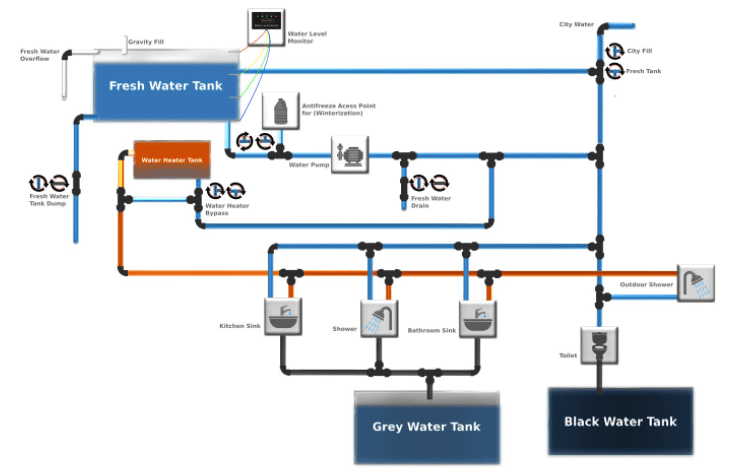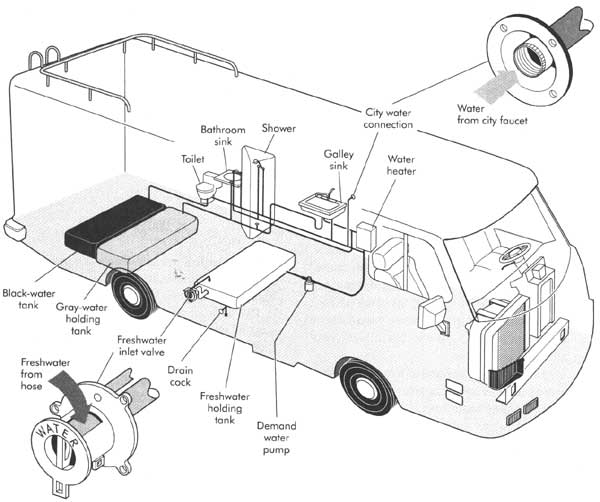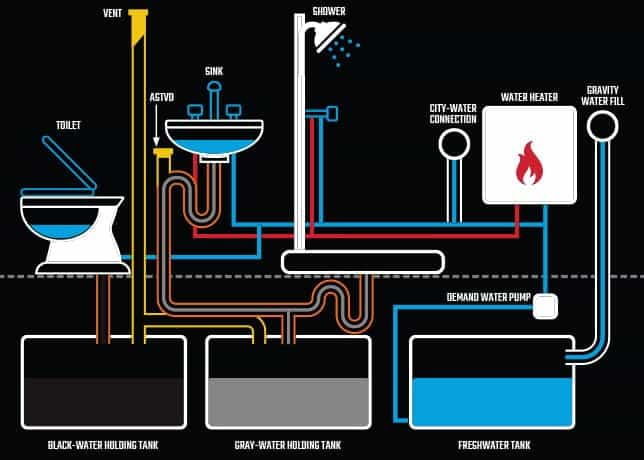Last Updated on September 19, 2023 by
RV functions involve a lot of understanding when it comes to plumbing and pipelining. There is a lot going on with the modern or an old RV system when it comes to plumbing. Each vehicle requires a repair or check with an interval of time; otherwise, there might be problems that are hard to overcome. The major issues are caused by drainage and flush systems in an RV.
For the ease of a user, it’s important that a user understands the working and functionality of each feature inside the RV so that he can repair things by himself or understand whenever something goes wrong. RV plumbing is almost the same as your home, which includes a whole phenomenon that can be explained with a diagram to clear any errors or problems in the line.
In this article, the whole RV plumbing diagram and schematics have been discussed briefly.
RV Plumbing Diagram and Schematics

Water Pump
The water pump plays a major role in the whole plumbing system. Its job is to pressurize the water lines, to circulate the water consistently. It is found right outside of the water tank, where it gets the water through itself and into the central pipe.
The 12-volt water siphon ought to be wound down when you’re not going to be close to the RV. In case that something turns out badly and you get a hole, you will need to be there to restrict the harm. In case you are at the RV, don’t stress over it.
Water siphons are on-request gadgets. They tend to work to detect an absence of strain in the lines; they will do whatever it takes not to siphon the water. For RV plumbing, a couple of holding tanks are required. There are three tanks in an RV, four in case that you count the water warmer.
One is intended for clean water. The other two tanks store debased waters until you can deliver them into the sewer. The filthy water tanks are called black water tank and grey water tanks, and they are only meant to be used in drainage and sewer system.

Types of RV Holding Tanks
When there is a condition that the water pressure stays low, some water pumps can need additional help from the assistant water pump. It helps to rapidly pump cycles on and off to keep the pressure maintained. Utilizing a pre-compressed air bladder, these gadgets add the required strain to the lines, so the water siphon won’t have to cycle on once more.
This additional tension facilitates the weight on the siphon and broadens its life. Holding Tanks can be introduced anyplace inside the compressed pieces of the pipelines. In case that you check out the RV plumbing graph, it tends to be put anyplace on the hot (orange) or cold (blue) lines.
Camping Gear SALE!
We have teamed up with Ape Survival to give you a huge 25% off EVERYTHING on their store! They have camping gear, hiking gear, survival gear and much more, all at 25% off when you click the link below.
SHOP NOW
1. Fresh Water Tank
New water for your RV can be gotten in 2 distinct ways. In case you are snared to city water, it goes straightforwardly into the different lines inside your RV and feeds water straightforwardly. It’s important to keep fresh water in the waterlines because it will keep little trash out of your water siphon.
While holding the freshwater, when you turn your spigot on, water will come out that you can use for your dishes and another purpose. Between the new water tank and your different water outlets will be a 12 Volt DC Water Pump that pulls water from your tank and compresses your water lines, very much like city water.
This water siphon will have an on/off change to begin things. Contingent upon how your framework is set up, most will have an air-filled tank that will keep a specific measure of strain inside your framework before it gets too low and afterward requires the siphon to cycle on.
If you are wondering how to clean and sanitize freshwater tanks then we have an article on it.
2. Grey Water Tank
All of the different water channels are connected to the Grey Tank. This tank can be/ought to be the biggest of the 2 waste tanks since it gets filled from the shower, sinks, and kitchen channels. The Grey Water Tank will have a rooftop vent to fend any scents off. This tank will have its own wastegate valve to deplete it.
The state of both the Black and Grey Tank is with the end goal that it has a “depressed spot” in it to work with it depleting rapidly.
3. Black Water Tank
This type of water tank is meant to store the wastewater coming from the latrine or your washroom. It holds all the wastewater in one place, so just a latrine squander is placed into it. This tank also has its own waste dump valve to exhaust that tank. It will ordinarily have a new water wipe-out valve so your Black Tank can be flushed out with new water, subsequent to depleting it.
Check this article on how to clean and sanitize blackwater tank?
Water Heater
RV water heaters are a source of warming up the water for winters in case you don’t want to use the frozen or icy cold water from the pipelines. These are fueled by propane, power, or both. As water is pushed through the water lines, a portion of that water is constrained into the water warmer’s tank.
As the water warms, it ascends to the highest point of the tank. At the point when a fixture or shower needs boiling water, that water is pulled from the highest point of that tank and into the heated water lines.
Camping Gear SALE!
We have teamed up with Ape Survival to give you a huge 25% off EVERYTHING on their store! They have camping gear, hiking gear, survival gear and much more, all at 25% off when you click the link below.
SHOP NOWThe discharging tank decreases the strain of the pipes framework, which triggers the siphon to top off the lines and heated water tank with more water.
Some Tips To Keep Plumbing Lines Secure
The water radiator ought to never be turned on except if the pipes are compressed. The warming component will wear itself out without water to lead the hotness away from itself. It can take not exactly a moment before its copper parts start to dissolve.
An RV’s water radiator tank is simply 6 to 10 gallons, so it just takes around 5 to 10 minutes for the warming component to heat up the water. Hence, most suggest that you turn off the water radiator when it isn’t required. It’ll save your battery control and possibly expand a boondocking trip.
Normal Drain Hose for both Black and Grey Tanks should be tested. After getting the channel hose, consistently “test” the channel associations with some Grey Tank and then channel the Black tank. Utilize the rest of your Grey Tank Waste to clean within your channel hose.
Don’t turn on your water heating appliance except if you are positive it has water tension from one or the other party or your new water tank. Continuously let some boiling water out of a fixture to make certain there isn’t any air bubble. Make certain to utilize a Pressure Regulator on your approaching lines before the water enters your RV Plumbing framework from a campsite source.
Your RV is a moving tremor for that load of fittings, and a water tension could undoubtedly be excessively high for your RV’s framework. There is a strain controller that can be added, which functions admirably, and you generally realize that your water pressure hoses are protected from a lot of strain. And don’t put any water into your new water tank from a hose/nozzle, almost a dumpsite.
Conclusion
This was a discussion article that included an RV plumbing diagram and schematics along with necessary data to understand the plumbing system in an RV. We discussed all the water functions and drainage systems along with the water tanks that an RV has, which can be a problem if you don’t understand what’s wrong with your RV. For more details, you can leave questions about plumbing on our website.
FAQ
Is RV plumbing the same as house plumbing?
RV plumbing isn’t vastly different from conventional home pipes. Your RV plumbing permits you to shower, wash your dishes, and perform fundamental family tidy-up. Aside from the connectors, different components in your RV plumbing, including the sinks, is equivalent to what we use in our homes.
How do the pipes function in an RV?
The function is simple. Coldwater enters the tank at the base through tubing from the new water tank. This water then, at that point, fills the tank, which thusly compresses the heated water framework in your RV. Presently, when you turn on the high temp water valve on your spigots or shower, your RV plumbing framework pulls water straightforwardly from the water radiator tank.
What sort of line is utilized in RV plumbing?
Current RVs use the PEX line. It is less expensive and simpler to introduce than metal tubing. PEX tubing comes in all tones; however, red cylinders are typically utilized for boiling water and blue ones for cold water.
Are RV holding tanks vented?
The normal technique is to run the length of the thermoplastic ABS pipe from the holding tank up and through the top of the RV. Legitimate venting is vital, particularly as it identifies with smell control. Remember, as holding tank purges or sink channels. Outside air should enter the seepage framework.
Table of Contents
